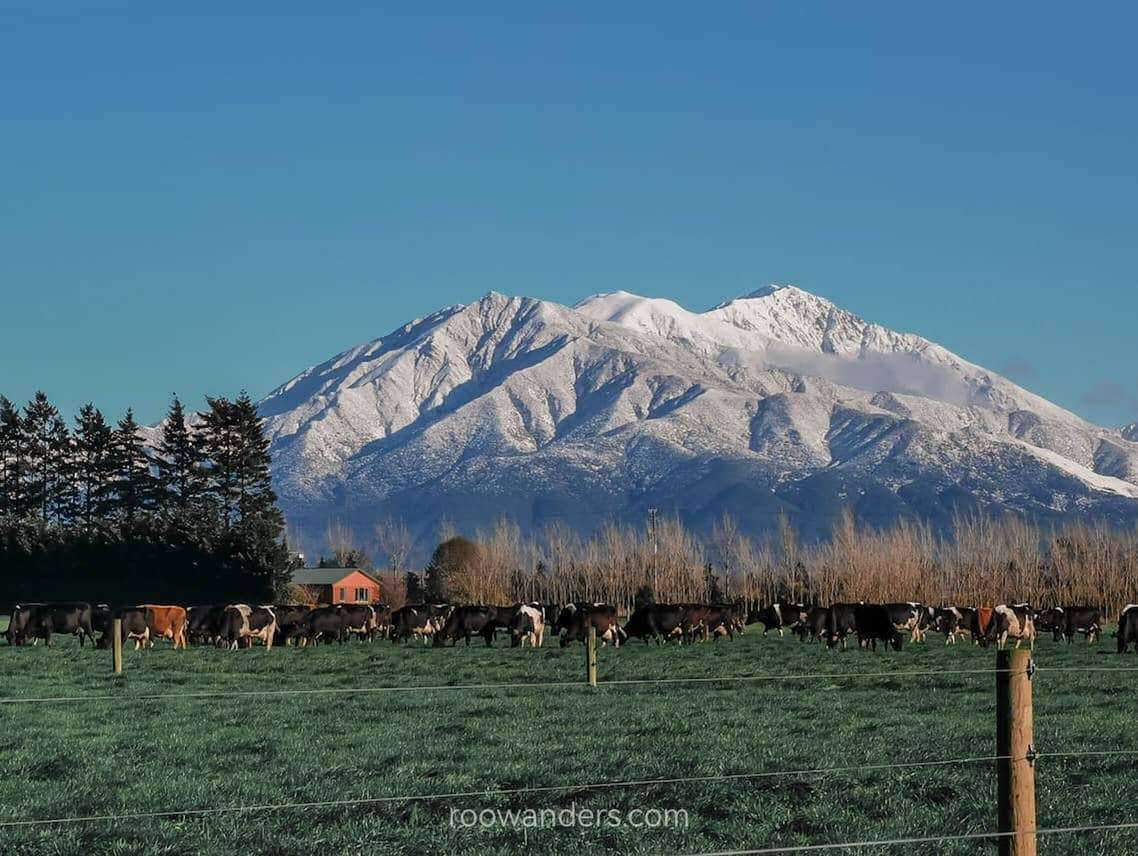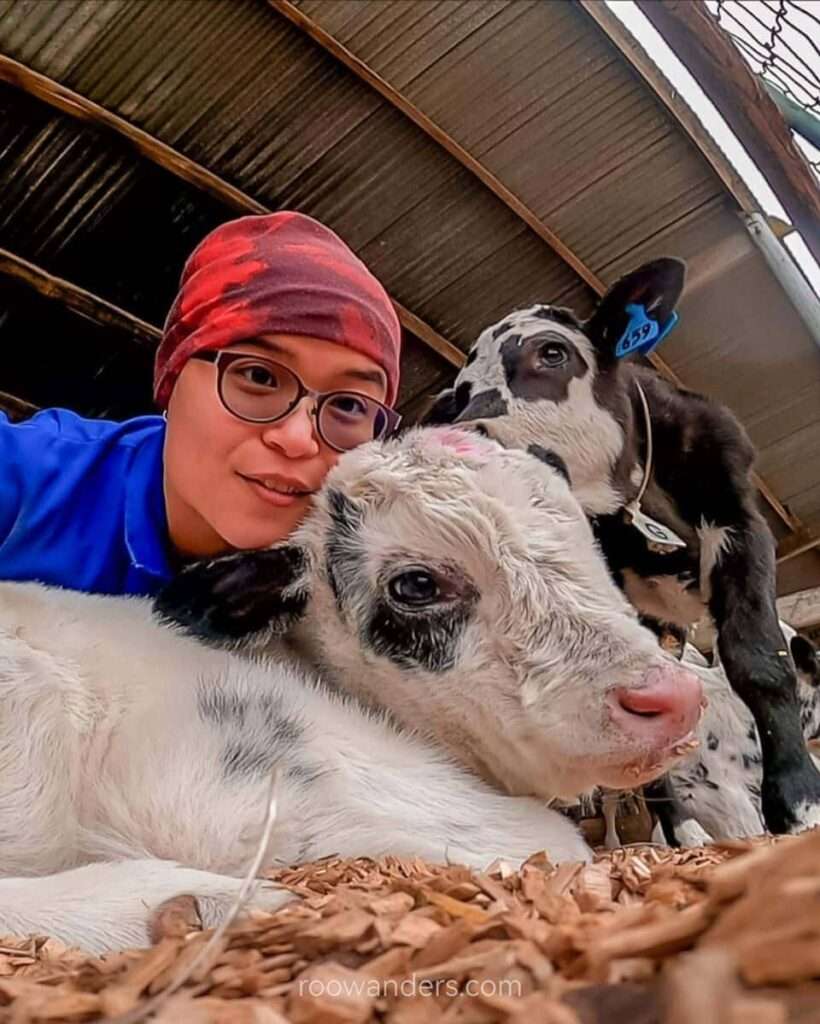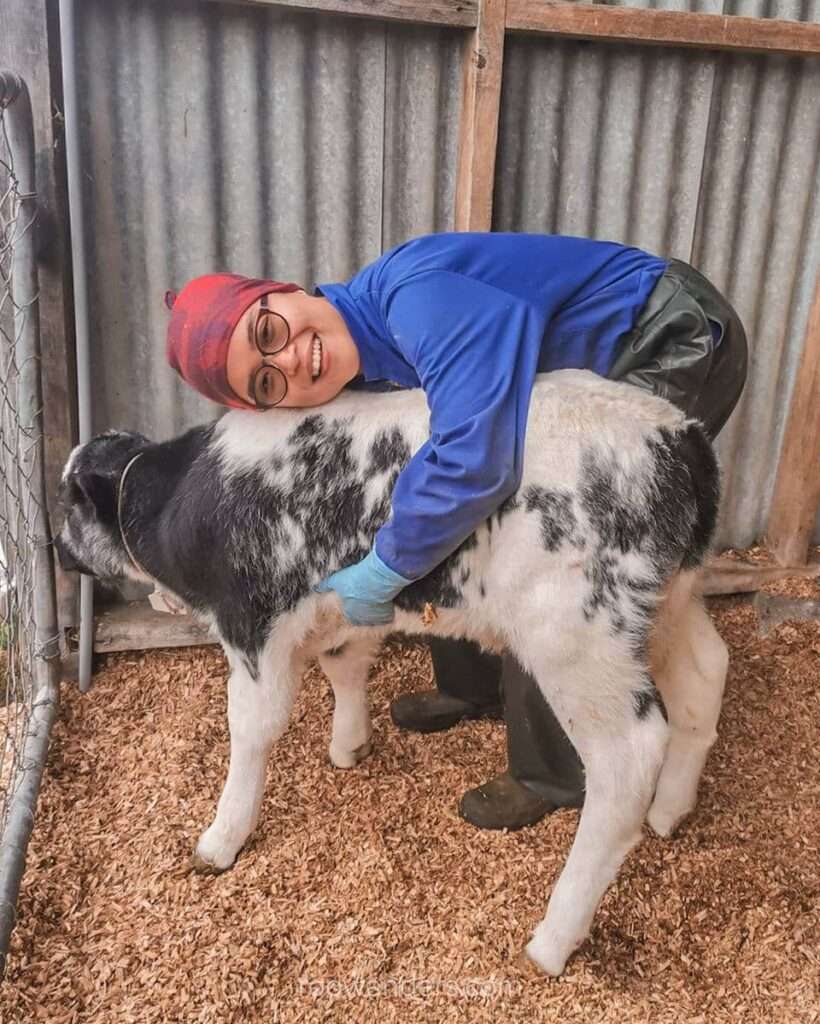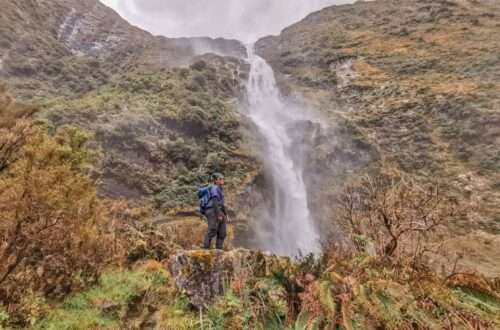
New Zealand Working Holiday Job #5: Calf Rearer
Sheep and cows roam aplenty in the land of the long white cloud. Having lived through the pandemic in New Zealand on a Working Holiday visa, I find myself incredibly lucky to score a job as a calf rearer in Canterbury. Rearing animals is a rare job for someone on a working holiday. So you could imagine my joy when I got the enviable job in New Zealand.
An opportunity to rear baby animals is not a job any Working Holidaymaker could have. If you managed to seize one, good for you! If not, this post is all about my experience as a calf rearer in the beautiful countryside of southern Canterbury.
I worked as a calf rearer in the winter of 2020. This post may be updated periodically. Since the border was still closed a year later due to the pandemic, my partner and I seized another opportunity to work as lamb rearers in Waikato.

Roles in A Dairy Farm
Before we go any further with calf rearing, let us go through the workings of a dairy farm.
To have milk, you need lactating cows. And to get that, you need them to have babies. No babies, no milk. The dairy farm works almost all year round and employs milkers to help collect milk using special machines and smart technology.
Milkers
Life as a milker looks tough to me. They have to be up early at 4.30 am – no late-night activities! – and work for more than 10 hours a day. Apart from milking the thousands of cows twice a day, they have to do housekeeping of the milking shed, maintenance of the paddocks and tend to the cows.
Two of my friends worked as milkers throughout the season, and it was fascinating to hear their stories. They experienced cases of being shocked by the electrical fences, and also shat on by the cows as they milk them since they have to approach them from the backside.
Essentially, milkers are the permanent roles in the dairy farm. They are treasured for their experience in managing the well-being of the herd.

Calf Rearers
Not all farms hire animal rearers. This is especially so when the farm is small. On the farm I worked on, there were thousands of cows, hence lots of babies during the rearing season. Helpers like us come in to help the farms tide over the peak baby season. The season ends for us when most of the babies are weaned off milk, and the permanent staff can manage themselves.
While I do not have to wake up in the middle of the night when I should be dead asleep, I still have to be up feeding the babies by 6.30 am every day in winter.
Smart Technology in a Dairy Farm
As I followed my boss around the farm, I realised that the farm I worked in had technology cleverly weaved in to track milking productivity. The cows have digital tags on their ears to identify them and track their health and milk levels. My boss could retrieve all that information with a tap on an app on his smartphone. He could even tell which cow was on heat and ready for a syringe of sperm collected from a prized bull elsewhere!
The app and systems in place truly opened my eyes to the technology catered for farms. What would a girl from a city have known if not for this short stint on a dairy farm?
Seasons in the Dairy Farm
Milking happens almost all year round, but rearing occurs only from late winter to early spring in New Zealand.
No babies, no milk.
A cow is milked for around 80% of a year from spring to summer to autumn. A month or two before she is due to pop the baby, the cow rests and recovers. The baby arrives somewhere between August and October – the months of late winter to early spring. Then the cow goes back to producing milk, and the milker goes back to milking, and the cycle continues.

Calves of a Dairy Farm
Calves from dairy farms are categorised based on their market value, in ascending value, we have the Bobbies, Beefies and Heifers.
Bobbies
Bobbies are usually bulls of milk-producing species like Fresian – the common black and white cows – or Jerseys – the brown cows.

From a business point of view of a dairy farm, the bulls are not useful since they cannot produce milk. On the farm I worked, Bobbies were fed four days before they were culled for their meat and skin. Nothing goes to waste.
On some other farms I knew of, Bobbies were shot and thrown into pits, which is a huge waste of resources.
Smaller and weaker female calves may sometimes end up in this category too.
Beefies
Beefies are calves of meaty species like the Belgian Blue and Hereford. These calves are bigger and heavier upon birth and are reared for their meat when they are two years old. These are the calves that give us the sirloins, ribeyes and shanks.

A week-old Beefie calf costs a couple of hundred dollars. A matured Beefie could cost a hundred times more.
Heifers
Heifers are female calves of milk-producing species. These calves contribute to the continuity of the farm and are carefully monitored and treated. They become dairy cows two years later.

Milk for The Calves and The Market
There are two kinds of milk collected from a dairy farm – milk for the calves and milk for the market.
Calves do drink milk from the cows on the farm I worked at. Colostrum collected from cows that have recently given birth goes back to the calves.
Milk from Day 1
Milk collected on the first day was for newborns. Milk with Brix – sugar levels – above 22 is called Gold Milk. Buckets of Gold Milk go to the Heifers and Beefies. The rest – sugar levels below 22 – is called Bobby Gold and goes to the Bobbies.

Milk from Day 2 to Day 4
Older calves feed on colostrum collected from the second, third and fourth day.
Milk from Day 5 and beyond
Milk collected from the fifth day and beyond is called Whole Milk and this goes to the market. Whole milk is collected twice a day on the farm I worked at by a milk manufacturer, Fonterra. At this stage, the milk is raw and needs to be processed to what we would find in the supermarket – whole milk, reduced-fat milk, low-fat milk and skimmed milk.
Untreated milk is unpasteurised and non-homogenised and has a strong animalic or cowy note. A fat layer would surface above the milk if left undisturbed.
I have also tasted colostrum out of curiosity. It was sweet and tasted like melted butter.
Raw milk generally has a higher fat content and varying nutrient levels depending on the season and what the cow eats. What we get in the supermarket is milk that has been processed to have nutrition levels that meet the market demands. To be called Whole Milk, the milk needs to meet a fat content of 3.3 g/ 100mL in New Zealand.
As the colostrum level falls towards the end of the season, milk for older calves may be mixed with whole milk. I learnt that letting calves drink pure whole milk could lead to diarrhoea, which is strange when it is still unprocessed.
My Day as a Calf Rearer
My day began as early as 6.30 am but that dwindled to 8.30 am towards the end of the season as the number of newborns fell.

Feeding the Bobbies
The first chore on my list was to check the number of new Bobbies in the shed with my supervisor. These newborns were brought in either the night before or early in the morning by the milkers making their rounds around the paddocks. The bobbies were tubed 2 L of Bobby Gold each.
Tube feeding delivers beneficial antibodies and vitamins into the calf's empty stomach. This process is so important as it sets their health right for life. The babies have to be tube fed within 12 hours of their birth, no matter if they have had some milk from their moms or not.
Older Bobbies were fed with leftover colostrum or fresh ones depending on what was available. Those beyond four days old were fed first as they would be sent off later in the morning.
Once we had identified and tube-fed the newcomers, our next task was to feed the rest and teach the two-day-olds to feed from the feeders. Teaching calves to drink is like teaching a kid to study. It can be fast and straightforward for some, but there will always be a few that need more help.

After feeding the Bobbies, we would pick up a 500 L milk container on wheels known as the calfeteria.
Feeding the Beefies and Heifers
With the Bobbies done, we towed the filled calfeteria to feed the other babies on the farm. The first on the list is the Beefies. The same process goes – we tubed the newcomers, taught the two-day-olds, and fed the rest. The Heifers came next.
Unlike Bobbies, Beefies and Heifers must be tubed 4 L of Gold Milk each.
Morning came to a close with a brief rinse of the soiled feeders and tubes. We then break for an hour or two for lunch and a short nap.

Afternoon Duties
After lunch, we would go through all the sheds again and tube the newborns.
Heifers that were less than 10 days old were given another serving of colostrum in the afternoon. I filled the rest of the day by either cleaning their sheds or bringing them hay and grains. Towards the later end of the rearing season, my partner and I would sometimes help the staff to transport the month-old babies to new paddocks.
The day ended with a final washdown of all feeders, pails and tubes with hot soapy water.
Life of the Heifers
Heifers are the livelihood of the dairy farm, hence they are very much well-taken care of. The princesses enjoy plenty of colostrum, grains and hay in their pens, compared to other categories of calves.
Heifers live in the shed from birth till they are about one month old. Towards the end of the month, vets would be called in to dehorn the calves under sedation. The babies would then be released into paddocks, and continue to grow until they reach 100 kg.

On the farm I worked in, each paddock consisted of about 50 calves or three pens of calves.
During this period, the calves would continue to enjoy a mix of milk-colostrum concoction once a day. This is on top of their usual free flow of hay, grains and ample green grass.

Once the Heifers reach the minimum weight, the staff would transfer them to another bigger paddock and wean them off milk.
When the calves are two years old, they go back to the dairy farm as working cows and join the other older dairy cows in milk production.
The milk quality of each cow is checked up to four times a year.
Cows that consistently do not meet the quality standards would be culled. As these cows are usually older and are not from the meaty cattle species, their meat would become mince and sausages.
The oldest cow on the farm I worked in was nine years old.

My Relationship with Meat and Dairy Products
Some friends and family members questioned my relationship with milk and meat upon knowing my current work.
Do you still eat beef or drink milk despite working with these animals?
I understand why some people choose to be vegans. But I am not here to discuss the diet or the environment.
Meat and animal products have always been a part of my diet. Growing up in an Asian family meant stewed and stir fry meat dishes, and soupy ones with bones thrown in. Soupy dishes with a bit of meat are my favourites. These are comfort foods. I don’t think I’m ready to give all those up yet. Besides, I love sampling all kinds of food from different cultures and different countries as I travel.
Rather than becoming a vegan and eliminating all meat products, I choose to be a flexitarian and consume what I need. Life is too short to think of what to include or exclude. Enjoy everything in moderation.
Ultimately, it is a person’s choice to have or not have animal products. What is important is to understand the source of the food you’re having and understand the work that goes into producing it. Be grateful for the food and not waste what you are eating.

Ending
Five weeks with the calves rolled by in a flash. Working with animals may be tough, but at the end of the day, I always have the feeling that they paid me to play with the baby animals.
A year down the road and I went back to rearing lambs on the North Island. The New Zealand Working Holiday, coupled with the pandemic, opened rare opportunities like these for me.
If you would like to experience rearing too, look out for them in the backpacker’s board closer to June. Farmers usually prefer someone who has already worked in New Zealand with local testimonies to refer to. Else, you could do a short-term role with the various work exchange platforms like Woofing or HelpX. Best of luck!
Video







